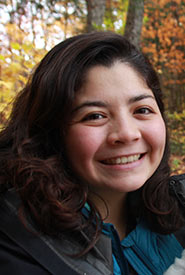Monarch migration reflections
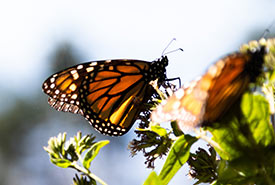
One of the millions of monarchs I saw in the Monarch Butterfly Biosphere Reserve in Michoacán, Mexico (Photo by Alberto Becerra)
I am an immigrant to this country, as are most people across this diverse continent with such a complex history. In fact, all who are not indigenous to this land are immigrants. When I was just a toddler, my family and I immigrated to Canada from Mexico. My father had received a scholarship to complete his master’s degree at the University of Toronto. Hoping for a safer and more promising future for their children, my parents jumped on the opportunity. They left their entire lives and loved ones behind, and, with three young children in tow, came to Canada. I have been fortunate enough to visit Mexico over the course of my life and have kept a connection with my grandparents, aunts, uncles and cousins, despite living about 4,000 kilometres away from the place I was born.
In our earlier years living in Canada, we even made the 4,000-kilometre drive down to Mexico a few times to make it home for the winter holidays to see family. This was partly because it was more affordable to drive than to fly, for a young family, but also because of my dad’s keen sense of adventure.
Related content:
Growing up in Canada, I have often wondered how different my life would have been had my parents never made the decision to move to a country that’s so vastly different from where we are from. Would I still have such a passion for nature and adventure? Would I feel more connected to the land I lived on? I have come to accept that I may never have the answer to some of these questions.
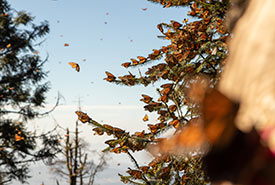
Monarchs covering the oyamel fir trees was a spectacular sight (Photo by Alberto Becerra)
On my most recent visit to Mexico this past winter, I encouraged my relatives to come with me to visit the Monarch Butterfly Biosphere Reserve in Michoacán, Mexico. Like me, monarch butterflies have more than one home. They migrate over 4,000 kilometres across the North American continent, from Canada and the U.S. to their wintering sites in the mountains of central Mexico. Millions of butterflies arrive to congregate on the oyamel fir trees. It’s something that is hard to even imagine or believe until you see it, and hear, it for yourself. The trees were completely covered, and the branches were weighed down with millions of monarchs that travelled so far to get there. I could hear the collective sound of all the monarchs shuffling around on the trees and flying above as the sun hit the branches they were resting on. All the fellow tourists fell silent, partially because we were asked to be quiet to not disturb the monarchs, but also because we all watched in awe at such a phenomenal natural wonder. It was one of the most beautiful things I have ever seen.
Conserving monarchs on Canadian soil
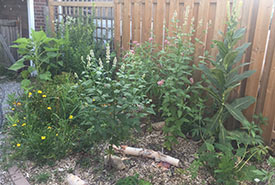
My pollinator garden (Photo by Sofia Becerra/NCC staff)
I came “home” back to Canada feeling inspired to continue my work in conservation, where the work I do as a GIS and conservation data assistant has a part in protecting habitat for so many species at risk. I felt more connected to this migration journey than ever, but also felt a deep sadness hearing from the local guides that the number of returning monarchs continues to decline every year. One of the biggest threats to monarchs in Canada, the U.S. and Mexico is habitat loss. Monarchs are dependent on milkweed — the only plant that monarch caterpillars consume as larvae. The reality in southern Ontario is that, apart from patches of protected lands and parks, a large portion of land has been developed into farmland, cities with endless mowed lawns and other development, leaving very little room for nature to thrive and milkweed plants to grow freely.
Early this spring, with monarchs still on my mind, I decided the best thing I could do locally was to create more habitat for the generations of monarchs arriving from south of our borders in my own backyard. I convinced my landlady that an open space in my backyard, which was once a driveway, would make an excellent native pollinator garden.
Resources for starting your native garden:
I did some research, talked to some knowledgeable friends and made a plan to naturalize this area, taking into consideration the sandy and rocky soils of the old driveway. There are endless resources on the internet and online groups to join, so I dove right in! I contacted some local plant nurseries, signed up for some free native pollinator plant programs, got in touch with my local seed library and horticultural clubs, and bought some native plants from local grocery stores. During this global pandemic, I managed to plant over 20 different species of native plants in this patch of my backyard, all while physically distancing.
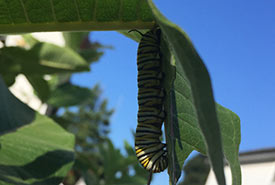
A monarch caterpillar hanging from my milkweed plant (Photo by Sofia Becerra/NCC staff)
I have been rewarded by the fact that, as of mid-July, I have welcomed back several monarch butterflies to lay their eggs on my common milkweed, swamp milkweed and butterfly milkweed. I have now found at least six monarch caterpillars eating the delicious (for monarch caterpillars) milkweed leaves. Watching them grow, little by little, has been a joy of mine every day in the past couple of weeks.
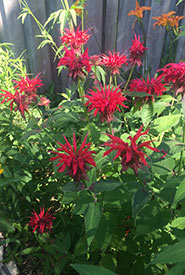
Bee balm (Photo by Sofia Becerra/NCC staff)
Native plants host exponentially more insects than traditional exotic horticultural plants, meaning that what we plant in our backyards really does matter! Personally, I have noticed more insects and lots of toads living in my garden. This naturally attracts more birds, such as the cedar waxwing in the bushes and the ruby-throated hummingbird I spotted on my beebalm. I feel especially lucky to have my home office facing out to this garden. I am reminded of the importance of the work I do in conservation, and the garden offers a bit of an escape when life gets busy. Watching this garden come to life has been such a blessing during these challenging times.
Connecting nature and place
As an immigrant, I feel more connected to this land when I learn about all the species that live here, the plants that support them and the journeys they have travelled. My father, who grew up loving the outdoors as a Boy Scout in Mexico, recently got back into hiking in the past several years. He started joining groups on Meetup.com and connecting with nature locally on day hikes and weekend camping trips. Not only does he feel much better mentally, physically and spiritually, he has also shared with me that he feels more connected to this place, and finally feels like he belongs, after living here for over 20 years.
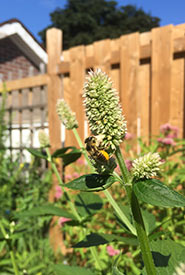
A bee on a giant purple hyssop (Photo by Sofia Becerra/NCC staff)
I have been fortunate enough to develop a love for backcountry canoeing, hiking and nature in some of the incredible landscapes we have here in Ontario and across the country. But I acknowledge that many new immigrants do not always have this luxury. Additionally, many people who live in cities do not have the luxury of a backyard. “Nature” is often considered to be somewhere else, outside of cities. It often requires expensive gear, and a car to get to. It’s truly time to redefine this idea of nature.
Nature is all around us, resilient and searching across the landscape for places to thrive in. In addition to protecting pockets of connected land across the province and the country, we can all work together to rebuild and connect ecosystems within the city, in our own backyards and in our city parks. In doing so, we will build a stronger connection and relationship to this land, and, hopefully, the original stewards of this land as well.
Finally, everyone should feel welcomed in nature and wilderness areas. It is up to all of us to dismantle barriers to access to nature and create spaces that can be enjoyed by people of all races, ages, sexual orientations, religions and identities.

